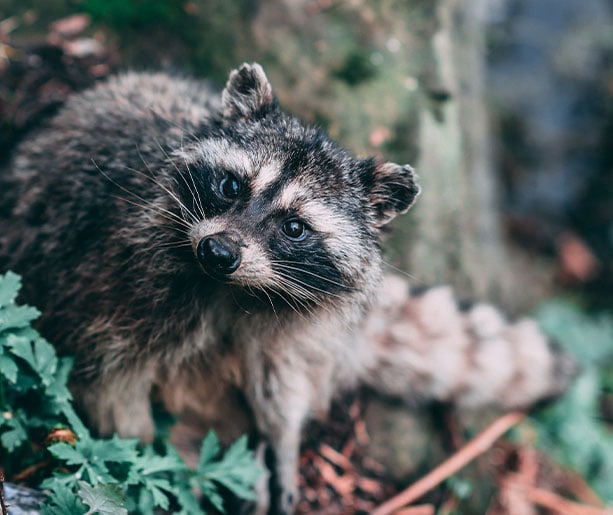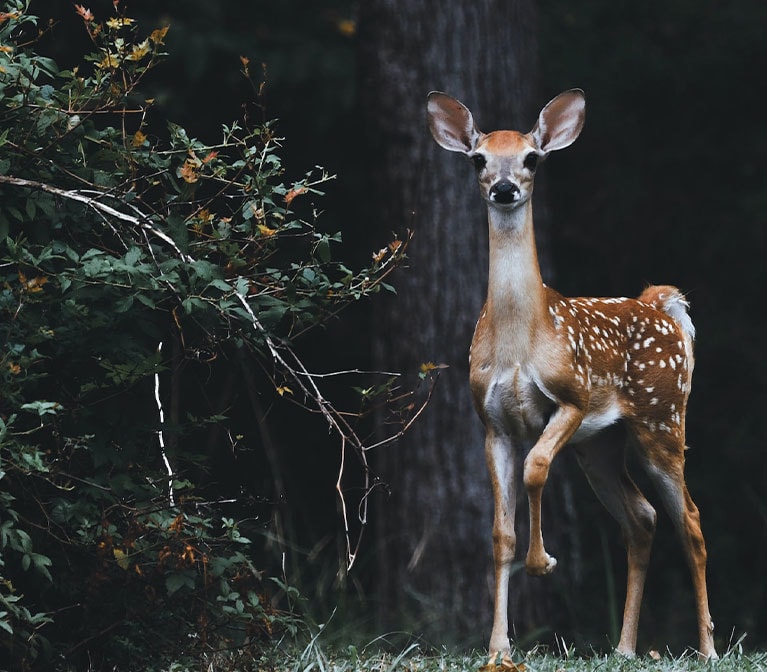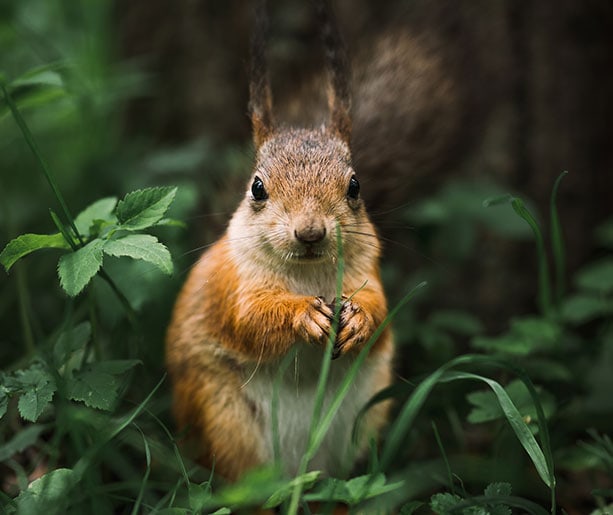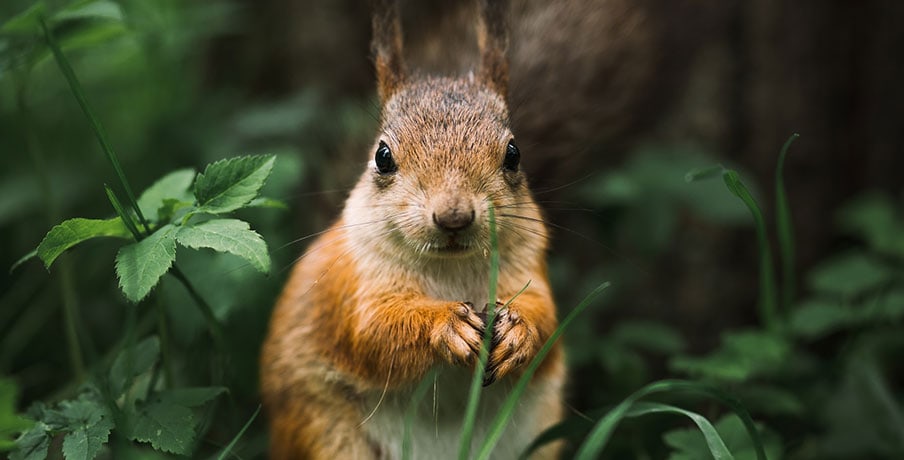Wild animals
What to do when you find a wild animal ?
Although cities are often considered to be inhospitable environments for wildlife, a number of small mammals have successfully made their homes in our man-made habitats. Consult here the page of the Ministère des Forêts, de la Faune et des Parcs for more information.
The shelter is not able to take in or care for wild animals. Need help with a wildlife animal? Contact us at 1 833-445-2525 extension 0 or info@proanima.com


When an injured animal is discovered, it is necessary to communicate with SOS Poaching before any intervention, because some animals are notifiable. Whether or not the cash is reportable, we recommend that you do not take any risks for your safety and that of others.
Found an injured animal?
According to the Ministère des Forêts, de la Faune et des Parcs of Quebec, when you find an injured, sick or dead animal you must follow these tips for your safety.
What to do in the presence of an injured or sick wild animal
In some cases, letting nature take its course may be the best option. Indeed, the death of wild animals is an integral part of healthy ecosystems and the survival of some animals depends on the death of other animals. Thus, a sick, injured or dead animal will serve as a meal for a predator who can use it to feed its own young and allow them to survive.
When near an injured or sick animal, the following safety instructions should be followed:
- Keep pets away at all times to minimize animal stress and prevent the spread of disease;
- Avoid staying close to the animal, as this could stress it further;
- Never attempt to intervene with an animal that could bite or injure you, such as deer, herons or raccoons.
Make sure the wild animal is actually injured or sick
Injured or dead wild animals can carry diseases that can be transmitted to humans. Therefore, it is important to avoid approaching or handling them. The following signs are most often noted in sick or injured animals:
- obvious sore, bleeding or injury;
- difficulty breathing or noisy breathing;
- discharge from the eyes or nostrils, sticking eyelids;
- difficulty moving around, getting up, or holding your head straight or up;
- lethargy or marked depression;
- soiled fur or feathers around the anus
- areas of skin devoid of hair or feathers;
- flightless birds with hanging wings.
Organizations to contact depending on the species:
- All animals (except for birds): Ministère des Forêts, de la Faune et des Parcs, at 1-844-523-6738.
- Birds:
- Union québécoise de réhabilitation des oiseaux de proie (UQROP) à Saint-Hyacinthe (514) 345-8521 #8427 ou (450) 773-8521 #8427
- Le Nichoir au 450-458-2809
- Clinique des oiseaux de proie au 450-773-8521, poste 8111
Found a baby squirrel?
Urban cohabitation with wild animals is often very difficult for them. You have surely already observed squirrel nests in unusual places such as on balconies or at the edge of a window. Mother squirrels must set up their nests to bring their young to safety, but forests are razed to make way for streets, leafy trees are cut down, and they are left with few options. Let us be patient and indulgent towards these mothers who manage as best they can while waiting for the trees to cover themselves with leaves in the spring and for them to be able to settle elsewhere more comfortably.
Baby squirrels are regularly carried from nest to nest by parents. It is therefore not unusual for a youngster to be dropped on the ground or lost in motion. If it is within easy reach of predators, it can be relocated to a nearby shrub or temporary nest. They must be observed from a distance so as not to deter parents from coming back for them or continuing to take care of them. The baby squirrel will only need assistance if it shows signs of general weakness or if the mother has not returned within 24 hours.
The steps to follow:
Watch the surroundings
Est-ce que le bébé est dans un nid, mais qui est tombé au sol ? Est-ce que le bébé traverse la rue, loin des arbres ? Est-ce que le bébé est seul ? Vérifier les alentours car ils le sont rarement. Notez l’endroit de la découverte et vérifiez si vous voyez des nids aux alentours (dans les crevasses, nids de branches et trous dans les arbres, par exemple). Notez les endroits.
Check if the baby is hurt
Est-ce qu’il y a du sang ? Est-ce que le bébé semble avoir été mordu ? Est-ce qu’il y a des œufs de mouche (petits grains de riz jaunâtres collés au pelage) ? Est-ce qu’il est déshydraté ? Si c’est le cas, contactez rapidement Écureuil Land : http://m.me/ecureuillandqc
Warm the baby immediately
Très important et à faire rapidement, même en été. Vous pouvez prendre une couverture de polar et mettre le bébé contre vous le temps de trouver une source de chaleur convenable. Ensuite, utilisez une bouteille d’eau chaude enveloppée dans un tissu ou un sac magique pour aider le bébé à maintenir une chaleur corporelle adéquate (il ne régule pas eux-même leur température avant 8 semaines environ). Mettez-le dans une boîte de plastique (évitez le carton) avec des couvertures de polar et la source de chaleur choisie quand vous êtes à la maison.
Try to reunite him with his mother
Le matin tôt ou en début de soirée sont les moments idéals pour tenter une réunion. Si le bébé n’EST PAS blessé, n’a pas d’œuf de mouche et semble en bonne santé, il faut impérativement tenter un retour avec la mère. Cela restera toujours la meilleure solution pour eux. Une maman reprendra son bébé même si vous l’avez touché avec vos mains.
Should I feed the baby squirrel?
La réponse courte est NON. Mais le bébé peut être déshydraté, il aura alors besoin de Pédialyte tiède, et ce, uniquement lorsque le bébé sera réchauffé et avec une seringue adaptée. NE DONNEZ JAMAIS DE LAIT DE VACHE OU DE LA NOURRITURE à un bébé écureuil.
Vous trouverez la procédure complète de soin dans le guide de soins d’urgence pour bébés écureuils, disponible ici : http://bit.ly/ecureuilland
Give him a dark and quiet shelter
Installez une boîte en plastique dans un lieu tranquille, loin des jeunes enfants et des animaux de compagnie. Ne le dérangez pas plus que nécessaire.
Read This Before Picking Up A Baby Squirrel That Seems Lonely
If you find a baby squirrel, it is not always necessary to pick it up and bring it to your home. When the good weather returns, some babies begin to venture out of their nest, sometimes a little far.
If the baby has its eyes closed, is hurt, or is climbing on top of you on its own, this indicates that it needs help and you need to act to help it quickly.
BUT… If he’s having fun, being mobile and playing, just watch him from a distance to make sure predators won’t attack him and to make sure the mother comes back for him. We avoid feeding them, especially with nuts, fruits or any form of milk (cow’s milk and infant milk are to be avoided, among others).
If the day is over and the sun is about to go down and the mother still hasn’t come back then, yes, take him home for the night. Give him warmth and hydration (per the instructions above).
But you must try to reunite him with his mother early the next morning. You take it to where you found it and wait a while, watching it from afar, to see if the mother comes back for it. In many cases, it comes back.
The mother will take her baby back even if you touched her. Try several times throughout the day, returning to the same place with the baby. If she doesn’t come back, the baby is probably alone. You can then contact Écureuil Land. But you must try the reunion with the mother first.
Summary
The creation of “false orphans” is not a winning solution, as much for the mother as for the babies as for us. Patience is required if you have found babies (healthy ones). Moms will usually move their young within days. Sometimes it’s within the hour, sometimes 3 days later. Also, it’s okay if you touched the babies with your hands. Moms recognize their babies’ cries.
Need help with a squirrel?
Would you like to become a foster family for baby squirrels? Contact the Écureuil Land organization.



